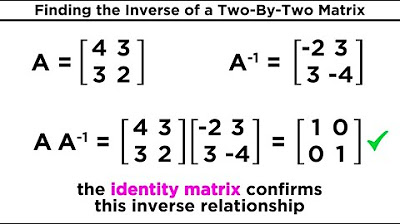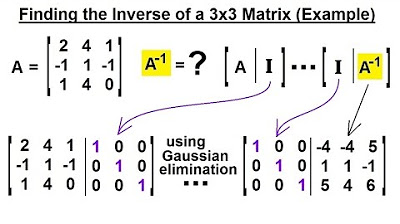PreCalculus - Matrices & Matrix Applications (20 of 33) What is the Inverse of a Matrix?
TLDRThis video script introduces the concept of the inverse of a matrix, explaining its definition and significance. It demonstrates the process of calculating the inverse through a step-by-step example, highlighting the relationship between the original matrix and its inverse, which results in the identity matrix. The script also touches on the importance of inverse matrices and teases upcoming videos that will explore more efficient methods for finding inverses and their applications.
Takeaways
- 🌟 The inverse of a matrix is a special matrix that when multiplied with the original matrix, returns the identity matrix.
- 🔍 Not all matrices have an inverse; if an inverse exists, it is denoted as A^(-1) where A is the original matrix.
- 📐 To find the inverse of a 2x2 matrix, one can set up a system of equations based on the property that A * A^(-1) = I, where I is the identity matrix.
- 👓 The elements of the inverse matrix can be determined by solving a set of linear equations derived from the matrix multiplication with the identity matrix.
- 🧩 Once the elements of the inverse matrix are found, they can be cross-verified by multiplying the original and inverse matrices to confirm the identity matrix is obtained.
- 🔢 The process of finding the inverse involves setting up equations based on the elements of the original matrix and solving for the unknowns in the inverse matrix.
- 🎯 Two key equations derived from the process are: 2a + c = 1 and 5a + 3c = 0, which help in finding the values of a and c.
- 📌 The relationship between elements of the original and inverse matrix can be simplified to d = -2b and c = -5/3a, which simplifies the process of finding the inverse.
- 🔑 Once the values of a and b are determined, the remaining elements c and d can be easily found using the established relationships.
- 🚀 The inverse of a matrix has practical applications and will be explored in further videos, demonstrating its utility in solving various problems.
- 🌐 The video promises to introduce more efficient methods for finding the inverse of a matrix in upcoming content.
Q & A
What is the inverse of a matrix?
-The inverse of a matrix is another matrix such that when it is multiplied by the original matrix, the result is the identity matrix. It is denoted as A^-1, where A is the original matrix.
Is every matrix invertible?
-No, not all matrices are invertible. Only square matrices (matrices with the same number of rows and columns) may have an inverse, and even among them, some do not have an inverse.
What is the definition of the identity matrix?
-The identity matrix is a square matrix in which all the elements of the main diagonal are 1 and all other elements are 0. It is the multiplicative identity for matrices, meaning that any matrix multiplied by the identity matrix will result in the original matrix.
How can you determine if a matrix has an inverse?
-A matrix has an inverse if it is square (same number of rows and columns) and if its determinant is non-zero. The determinant provides a measure of how much the matrix scales space, and if it is zero, the matrix is singular (non-invertible).
What are the elements of the inverse matrix A^-1 in the given example?
-In the given example, the elements of the inverse matrix A^-1 are a = 3, b = -1, c = -5, and d = 2.
How can you verify that a calculated inverse matrix is correct?
-To verify that a calculated inverse matrix is correct, you multiply the original matrix by the inverse matrix (or vice versa). If the result is the identity matrix, then the inverse matrix is correct.
What is the commutative property in the context of matrix multiplication?
-The commutative property does not generally apply to matrix multiplication. However, when dealing with the inverse of a matrix, the property that the product of a matrix and its inverse equals the identity matrix does not depend on the order of multiplication (i.e., AB = BA = I, where A is the original matrix, B is its inverse, and I is the identity matrix).
How many equations and unknowns are there when finding the inverse of a 2x2 matrix?
-When finding the inverse of a 2x2 matrix, there are four elements in the matrix (two rows and two columns), which means there are four unknowns to solve for (a, b, c, and d). This results in four equations based on the requirement that the product of the matrix and its inverse must equal the identity matrix.
What is the relationship between the elements b and d in the inverse matrix?
-In the given example, the relationship between the elements b and d in the inverse matrix is that d equals -2b. This relationship is derived from the equation 2b + 1d = 0, which simplifies to d = -2b when rearranged.
What is the relationship between the elements a and c in the inverse matrix?
-In the given example, the relationship between the elements a and c in the inverse matrix is that c equals -5/3a. This relationship is derived from the equation 5a + 3c = 0, which simplifies to c = -5/3a when rearranged.
What are some applications of the inverse matrix?
-While the video does not go into specific applications, inverse matrices are used in various fields of mathematics, physics, engineering, and computer science, including solving systems of linear equations, finding the inverse of transformations in geometry, and analyzing systems in control theory.
What other methods can be used to find the inverse of a matrix besides the one demonstrated in the video?
-The video mentions that there are other, more efficient methods to find the inverse of a matrix. These methods can include using the adjugate matrix, the Gauss-Jordan elimination method, or specialized algorithms for certain types of matrices like symmetric or diagonal matrices.
Outlines
📚 Introduction to Matrix Inversion
This paragraph introduces the concept of the inverse of a matrix, explaining its definition and significance. It clarifies that not all matrices have an inverse but if one exists, it is denoted as A^(-1). The inverse's primary property is that when multiplied with the original matrix (A * A^(-1) or A^(-1) * A), it results in the identity matrix, demonstrating the commutative nature of this operation. The paragraph then delves into a step-by-step process of calculating the inverse of a 2x2 matrix using a given example, illustrating how to set up and solve a system of equations to find the unknown elements of the inverse matrix. It concludes by verifying the calculated inverse by multiplying it with the original matrix to obtain the identity matrix, thereby confirming the accuracy of the method.
🔢 Verification and Further Applications of Matrix Inversion
This paragraph continues the discussion on matrix inversion by verifying the calculated inverse of a 2x2 matrix. It demonstrates the multiplication of the original matrix with its calculated inverse to obtain the identity matrix, confirming the correctness of the inverse. The paragraph then briefly touches on the practical applications of matrix inversion, hinting at its powerful uses in various mathematical and real-world problems. It concludes by mentioning that future videos will explore more efficient methods for finding the inverse of a matrix and its potential applications, encouraging viewers to stay tuned for further insights into this mathematical tool.
Mindmap
Keywords
💡Inverse of a matrix
💡Matrix multiplication
💡Identity matrix
💡Singular matrix
💡Determinant
💡Linear dependence
💡Commutative property
💡Equations and unknowns
💡Zero matrix
💡Linear algebra
💡Matrix elements
Highlights
The definition of the inverse of a matrix is introduced, explaining its fundamental role in mathematics.
Not all matrices have an inverse, which is an important concept to understand when working with matrices.
The notation for the inverse of a matrix is explained, using the example of matrix A and its inverse A^-1.
The relationship between a matrix and its inverse is described, where multiplying them results in the identity matrix.
A step-by-step process for calculating the inverse of a 2x2 matrix is provided, using a systematic approach.
The commutative property of matrix multiplication is discussed in the context of matrix inverses.
An example matrix with elements 2, 1, 5, and 3 is used to illustrate the process of finding its inverse.
A set of linear equations is derived from the requirement that the product of a matrix and its inverse yields the identity matrix.
The solution to the system of equations reveals the elements of the inverse matrix when the original matrix elements are known.
The video outlines the use of substitution to simplify the process of finding the inverse of a matrix.
The verification process of the calculated inverse is demonstrated by multiplying it with the original matrix to obtain the identity matrix.
The practical applications and significance of matrix inverses are hinted at, promising further exploration in upcoming videos.
The video sets the stage for introducing more efficient methods for calculating matrix inverses in future content.
The process of solving for the unknowns in the matrix inverse calculation is shown to be systematic and solvable.
The video emphasizes the importance of understanding the inverse of a matrix for solving a variety of mathematical problems.
The video concludes with a teaser for future content, encouraging viewers to stay tuned for more on the topic of matrix inverses.
Transcripts
Browse More Related Video

Inverse Matrices and Their Properties

Find the Inverse of a Matrix (Calculate Inverse Matrix)

PreCalculus - Matrices & Matrix Applications (23 of 33) Finding the Inverse of a 3x3 Matrix

PreCalculus - Matrices & Matrix Applications (22 of 33) Using Gaussian Elimin. to Find the Inverse

7.2.4 Identity and Inverse Matrices

PreCalculus - Matrices & Matrix Applications (21 of 33) Using the Determinant to Find the Inverse
5.0 / 5 (0 votes)
Thanks for rating: